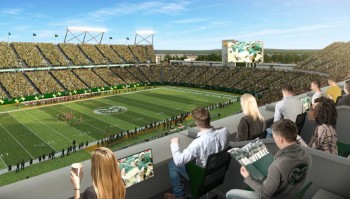 CSU has one goal for game-day parking and transportation logistics when the on-campus stadium opens in September 2017: Find practical solutions for both the campus and the Fort Collins community.
CSU has one goal for game-day parking and transportation logistics when the on-campus stadium opens in September 2017: Find practical solutions for both the campus and the Fort Collins community.
The CSU-City Game Day Transportation Working Group, a subcommittee of the Game Day Experience Committee, is rolling out a preliminary framework for game day operations and asking for input before a plan is finalized in the fall.
Fred Haberecht, assistant director of campus planning in CSU’s Department of Facilities Management and a member of the transportation subcommittee, says that the framework takes a multi-modal approach and illustrates proposed solutions to the game-day parking and transportation puzzle. It includes recommendations for freeing the 8,500 parking spots for game-day parking and tailgating, and plans for getting fans on and off campus by transit, bicycle, car and foot.
“I think there’s a perception out there that if you’ve got a 40,000-seat stadium you need 40,000 parking spaces, and that is not the case at all,” Haberecht said. “Our research shows we will have a large number of Rams fans coming from on and off-campus, and traveling a variety of ways. We’re presenting a framework that is multi-modal and pays special attention to the impact to the Fort Collins community, minimizes traffic issues and maximizes safety while promoting a great game day experience that accommodates a long tradition of tailgating.”
Public comments, feedback encouraged
Haberecht emphasized the preliminary nature of the framework, adding that he’s hoping people take advantage of the three methods provided to make comments, ask questions or provide feedback:
- Stadium website: stadium.colostate.edu/gameday
- Campus and neighborhood forums , slated to begin in March and run through May (dates for the forums will be posted on the stadium “Game Day” site, once scheduled)
- Stadium Advisory Group (SAG) during public comment (www.SOURCE.colostate.edu/stadium-advisory-group)
SAG, a nine-member committee that includes representatives from the campus and community including businesses and neighborhoods near campus, was formed in October and meets monthly to discuss stadium-related issues. The group was formed as part of the Intergovernmental Agreement (IGA) between the city and CSU signed after the stadium was formally approved in December 2014 by CSU’s Board of Governors.
The IGA calls for CSU to provide $30 million to fund projects aimed at improving traffic flow and pedestrian and bike traffic in the area. Haberecht said $20 million worth of projects already are completed, currently under construction or in the final planning stages. More information about the status of construction projects on campus.
The new game-day framework proposes reassigning parking on campus for residence hall students on the six weekends per year when there is a home game. Under the current plan proposed, students would be required to move their cars Friday night and relocate to another on-campus lot such as the Westfall or Research Boulevard lots — or to the College Avenue parking garage. Once the game is over, normal campus parking will resume. This plan emphasizes containing parking within the perimeter of campus as much as possible while also encouraging multi-modal transportation to games.
Similar plans at other universities
Haberecht said CSU has worked closely with the city to establish a framework that mitigates the impacts related to an on-campus, multi-use stadium and that’s meant a lot of collaboration. Students, faculty and staff have also been involved in the planning process.
“The framework is similar to plans currently in place at several universities with on-campus stadiums that have tested and successfully mastered operations and logistics for transportation, parking and tailgating. So, we have good models in place that we can borrow from and that’s informed us in this process of building an operational game plan for our own on-campus stadium,” said Haberecht.
“We want to make sure everyone is accounted for, including faculty, staff and students who need access to parking on game days to work, study or do research.”
The preliminary parking and transportation plan for game day operations is available on the stadium “Game Day” Website. For information about the on-campus stadium, including a “construction cam” that tracks progress of the project, visit stadium.colostate.edu.